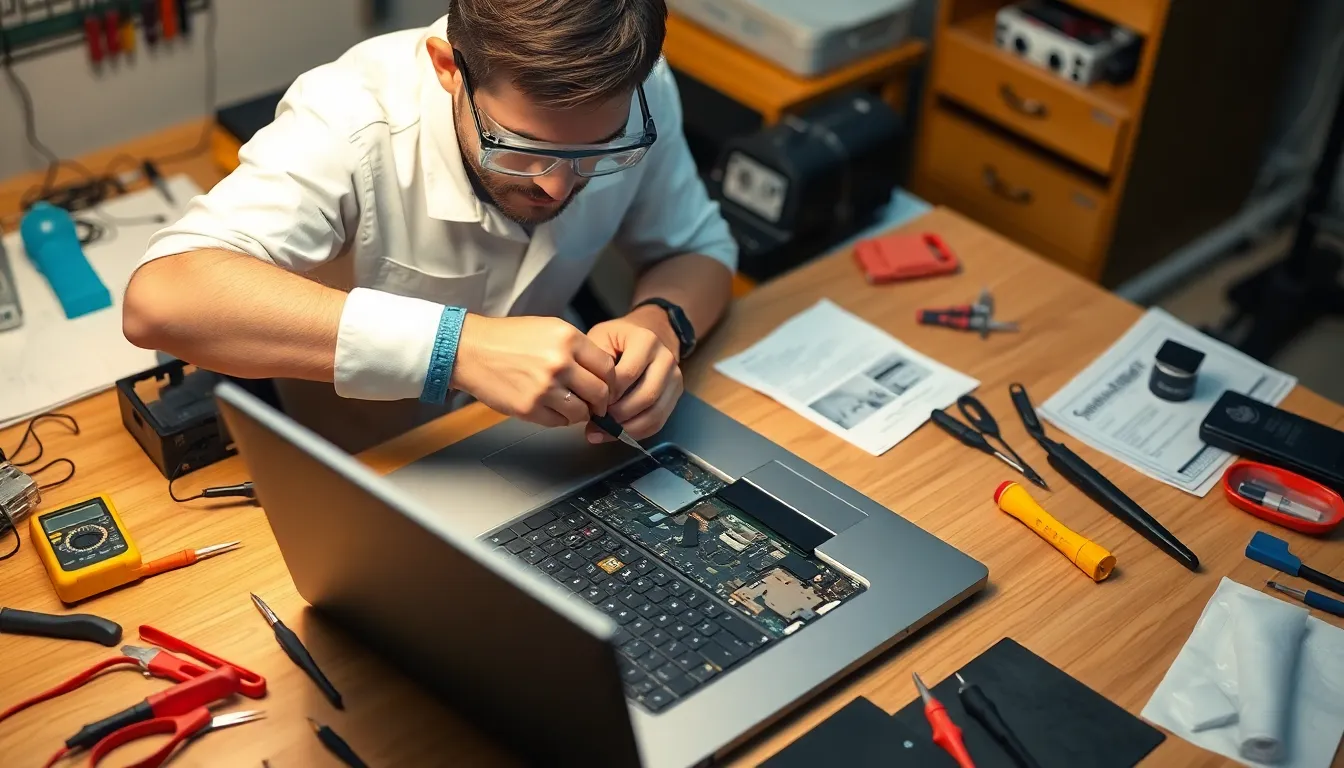Table of Contents
ToggleIn a world where laptops are the lifeblood of productivity, a sudden malfunction can feel like a personal betrayal. Whether it’s that dreaded blue screen of death or a keyboard that’s lost its will to type, laptop woes can throw anyone into a panic. But fear not! Laptop repairs are here to save the day, and they don’t have to break the bank or your spirit.
Imagine your laptop as a trusty steed, galloping through the vast plains of the internet. When it stumbles, it’s time to saddle up with the right repair service. From quick fixes to deep diagnostics, the right experts can get that trusty steed back on the trail in no time. So, let’s dive into the world of laptop repairs and discover how to keep that digital companion running smoothly and efficiently.
Common Laptop Issues
Laptops often face various problems that can hinder performance and usability. Identifying these issues early helps in effective repairs and maintaining overall productivity.
Hardware Problems
Overheating frequently occurs due to dust buildup or insufficient ventilation. Battery issues arise when batteries degrade over time, leading to shorter usage intervals. Broken screens sometimes happen from accidental drops, affecting visibility and usability. Loose connections may cause hardware components to malfunction, disrupting power supply or connectivity. Frequent crashes can signal a failing hard drive, necessitating immediate attention.
Software Problems
Operating system errors often lead to unexpected crashes or slow performance. Malware infections might compromise system security, resulting in data loss or unauthorized access. Corrupted files can disrupt software functionality, especially for critical applications. Outdated drivers sometimes hinder hardware performance, causing compatibility issues with new software. Slow boot times often indicate the need for optimization or cleanup of unnecessary programs.
Tools Needed for Laptop Repairs

Having the right tools simplifies the laptop repair process. Specific tools ensure efficient work and effective repairs.
Essential Tools
Screwdrivers are vital for accessing internal components. A set of precision screwdrivers accommodates various screw types in laptops. Antistatic wrist straps prevent static electricity from damaging sensitive components. Multimeters allow users to test voltage and continuity, aiding in identifying electrical issues. Tweezers assist with handling small parts and connections. Finally, a cleaning kit keeps components dust-free and operational.
Optional Tools
While not necessary, some tools enhance repair effectiveness. A heat gun helps with adhesive removal during screen replacements. Thermal paste application tools improve heat transfer between chips and heatsinks. USB flash drives facilitate software installation or system recovery. Magnifying glasses assist in examining tiny components and connections. Lastly, laptop stands or mats create an organized workspace, providing easy access to tools and parts.
Step-by-Step Repair Guide
This guide provides a structured approach to diagnose and repair common laptop issues effectively.
Diagnosing the Problem
Identifying the root cause of a laptop issue requires a systematic approach. Start by observing the symptoms—does the laptop overheat, fail to boot, or display error messages? Next, run diagnostic software to detect hardware and software malfunctions. Checking error codes or running built-in system diagnostics helps narrow down the problem. Users should inspect physical components for visible damage, such as loose connections or battery swelling. Gathering detailed information about software errors assists in determining if updates or malware scans are necessary. Immediate diagnostics set the foundation for effective repairs.
Performing the Repair
Repairing the laptop depends on the identified issue. For hardware problems, first, unplug the device and remove the battery if applicable. Use precision screwdrivers to access internal components, taking care to label screws for easy reassembly. Cleaning dust buildup from fans and heat sinks combats overheating. If replacing parts, ensure compatibility by checking specifications. Software repairs involve uninstalling problematic applications, running malware scans, or performing system updates. When encountering persistent issues, consider restoring factory settings as a last resort. Each repair step demands attention to detail for successful laptop restoration.
Preventive Maintenance Tips
Preventive maintenance plays a vital role in extending a laptop’s lifespan and performance. Regular attention can prevent common issues before they become significant problems.
Regular Cleaning
Cleaning a laptop regularly prevents dust buildup, which leads to overheating and performance issues. Start by using a soft microfiber cloth to wipe the screen and keyboard. Compressed air helps clear out dust from vents and fans. Removing accumulated debris keeps components cool and functioning properly. Aim to clean the laptop every three months for optimal results. Accessing internal parts may require precision screwdrivers, especially for thorough cleaning. This preventative measure reduces the likelihood of hardware failure due to overheating.
Software Updates
Installing software updates ensures that an operating system and applications run smoothly and securely. Regular updates provide essential security patches that protect against vulnerabilities. Setting up automatic updates streamlines this process, keeping software current without user intervention. Updating drivers enhances compatibility with hardware, boosting overall performance. Schedule update checks at least once a month to ensure timely installations. This proactive approach contributes to a more effective and reliable computing experience, minimizing the risk of software-related malfunctions.
Maintaining a laptop’s performance is essential for productivity and peace of mind. By understanding common issues and taking proactive measures, users can prevent minor problems from escalating into major repairs.
Utilizing the right tools and following a structured repair approach can make a significant difference in the effectiveness of the repair process. Regular preventive maintenance not only extends a laptop’s lifespan but also enhances its overall performance.
Investing time in care and repair can ultimately lead to a smoother and more efficient computing experience.




